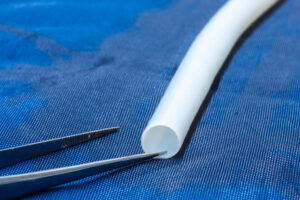
Humacyte recently announced the presentation of a clinical update on the Human Acellular Vessel (HAV) for the treatment of vascular trauma. The update was presented by Ukrainian surgeon collaborators, Oleksandr Sokolov (Dnipro State Medical University, Dnipro, Ukraine) and Vasyl Shaprynskyi (State Institution of Science “Research and Practical Center for Preventive and Clinical Medicine” State Administrative Department, Kyiv, Ukraine) at this year’s ESVS Annual Meeting (ESVS 2022; 20–23 September, Rome, Italy).
Humacyte notes in a press release that the company’s investigational HAV is designed to offer off-the-shelf availability and resistance to infection and to address long-standing limitations in vascular tissue repair and replacement.
Shaprynskyi attended the conference in person and presented a live talk entitled, “The first experience of using the Human Acellular Vessels in Ukraine for the treatment of patients with vascular trauma,” while Sokolov spoke virtually from Ukraine and presented, “Vascular trauma due to blast injury. Experience of Dnipro in Russian-Ukrainian war 2022.”
“Shaprynskyi and Sokolov have been instrumental in establishing their hospitals as medical strongholds during the Russian-Ukrainian war and reported that blast trauma, causing massive tissue damage and infected wounds, accounts for approximately 82% of incoming vascular trauma cases to their medical centres,” the press release reads. Trauma to the extremities makes up the majority of injuries, the statement adds, noting that these are primarily vascular injuries to the lower extremities and shoulders.
“Access to the HAV, a biologic conduit, has improved our ability to perform vascular reconstructions by eliminating the need to harvest a venous conduit and saving time required to look for useable vein, assisting greatly in limb salvation. While we continue to face this crisis in our country, partnerships with groups like Humacyte allow us to overcome many limitations in wartime medical care that we previously experienced such as lack of readily available conduits that are resistant to infection, particularly important in the contaminated battlefield setting,” said Dr. Shaprynskyi.
Drs. Shaprynskyi and Sokolov reported that surgeons in Ukraine have utilized the HAV to treat patients with a multitude of wartime injuries. Dr. Sokolov provided a clinical update on a patient with a blast injury to the shoulder who received a repair using the HAV. The patient is now beyond three-month follow up without complication. Another patient who suffered a blast injury to the lower leg underwent successful HAV implantation and is now one-month past surgery without complication. Dr. Shaprynskyi reported on a patient with a gunshot wound to the right thigh that was initially treated with a synthetic graft, but ultimately the graft failed due to infection, putting the patient at risk of limb loss. The HAV was used to replace the infected graft, and three months later the HAV is supplying blood flow to the limb and is infection free.
Humacyte worked closely with the Office of International Programs of the U.S. Food and Drug Administration (FDA) and the Ukrainian Ministry of Health to provide the HAV as an additional treatment option to those affected with vascular injury in Ukraine. Humacyte is currently evaluating the HAV in a Phase 2/3 clinical trial in vascular trauma for use as a vascular replacement to restore blood flow to a limb, when saphenous veins or synthetic grafts are not feasible. The HAV has received priority designation for the treatment of vascular trauma by the U.S. Secretary of Defense. The HAV is an investigational product and has not been approved for sale by the FDA or any international regulatory agency.
Laura Niklason, M.D., Ph.D., Chief Executive Officer of Humacyte, added, “As we progress in our humanitarian efforts with the HAV, being able to witness these firsthand patient cases from surgeons in Ukraine is a powerful experience. We set out to develop engineered replacement vessels that are durable, infection-resistant and off-the-shelf to address long-standing limitations in vessel repair, both for civilians and for military personnel. Given our existing designation as a Priority Product from the U.S. Department of Defense, it is gratifying to see that the HAV is helping patients suffering from wartime injuries in Ukraine right now.”












